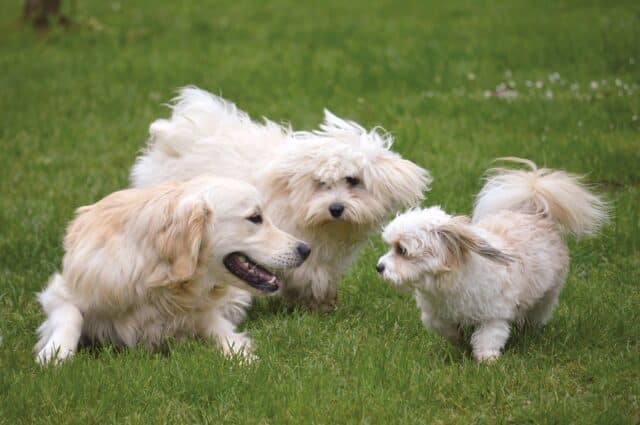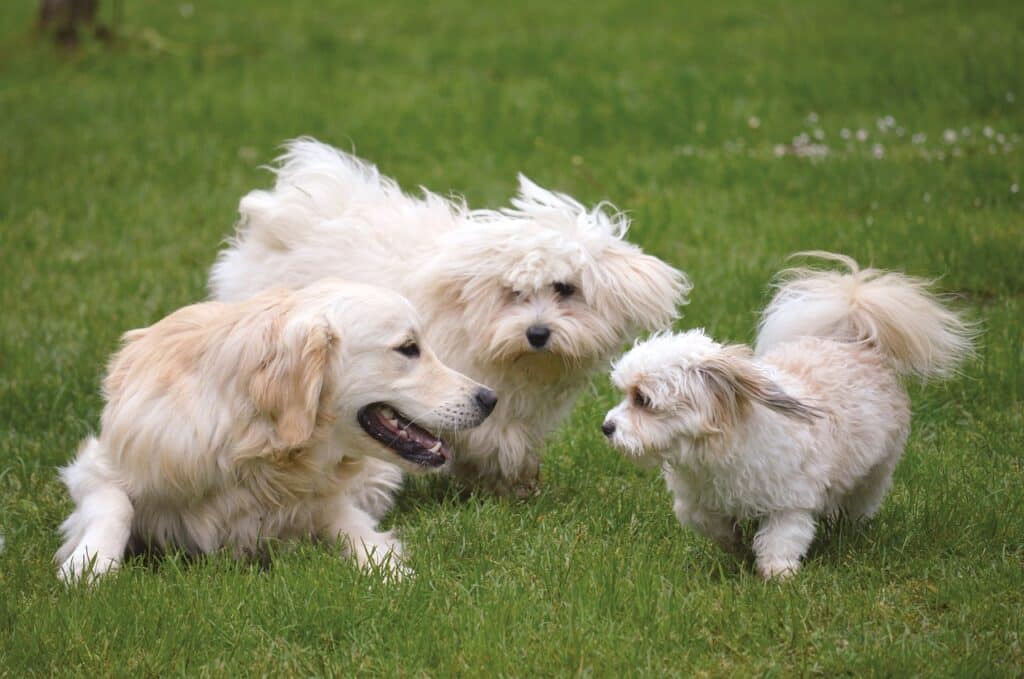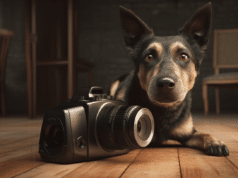
Note: Commissions may be earned from the links below.

The Importance of Socializing Your Dog
Socializing your canine is essential for their mental and physical health. A happily socialized dog is comfortable in its environment, confident around people, and happy with other animals. This promotes a healthy relationship between the pet and its owner, making life more fulfilling.
It’s best to start socializing when your pup is between 3-13 weeks old, as they’re most open to new experiences then. Expose them to different surroundings, sounds, people, etc., so they can adjust comfortably.
Begin with simple exercises, like introducing friendly strangers with treats or playing with other dogs in a controlled environment. Train them on basic commands like “sit,” “lie down,” and “come” too – this will build their obedience.
Remember to consider their individual temperament when you socialize them – every pooch has their own personality. Some may be shy or aggressive, so keep an eye on them.
Did you know that studies show that dogs who receive proper socialization training have less of a chance of displaying aggressive behavior? Get ready to bring out your dog’s social side – let’s get them paw-ty-ready!
Preparing Your Dog for Socialization
To prepare your dog for socialization, you need to start by addressing their training and behavior, as well as their health and vaccinations. These two sub-sections play an instrumental role in ensuring that your dog has a positive experience while interacting with other dogs and people.
Training and Behavior
For a dog’s well-being, socialization is essential. It can improve their behaviour and training. Here are three points to keep in mind when dealing with canine interaction:
- Start early, socialize the pup before 4 months old.
- Don’t introduce your dog to a group of unfamiliar dogs straight away. Gradual introductions are best.
- Watch your dog’s body language and behaviour.
Positive rewards must be used for training to have long-term benefits. According to a study by Dr. Christine Arhant of the University of Veterinary Medicine in Vienna, training effects on family dog behaviour last long-term if owners keep up with regular sessions. This shows that clicker training is just as successful as aversion techniques.
Raising a well-behaved, sociable dog takes effort and time.
Health and Vaccinations
Keep your furry friend healthy and safe by taking them for regular vet check-ups and immunizations. This is especially important if they are from a rescue home or shelter, as it can stop the spread of contagious diseases. Vaccinations help reduce the risk of catching deadly illnesses like rabies or distemper.
Places for Socializing Your Dog
Make your pup some new bark buddies! Check out these top places to socialize them
To help your dog thrive in various environments, you need to know the best places for socializing them with other dogs. Let’s look at some options.
Dog Parks
Dog Gathering Zones! Let your pup be a social butterfly without judgement. These areas provide owners and pets with benefits – like exercise and socialization skills. There are special zones for different dog breeds. Plus, no extra gear like muzzles is needed. It offers mental stimulation, reduces boredom and even an opportunity to bond with other pet owners. But, don’t forget to check the rules first – like having bags to pick up after your pup. And don’t forget to consult the vet to make sure your pup is healthy enough before taking them to a gathering zone.
Public Spaces
Head to public places with your furry friend for free! Parks, beaches, trails, and greenways are all great options. Just make sure there are off-leash areas indicated for pets. Big parks can have fenced runs or special dog sections with obstacles like tunnels, hoops, and poles.
Some playgrounds provide space for pooches to roam and interact. Neighborhoods also let the pup explore town life. Obedience classes in public parks teach good manners and discipline. Dog events create a unique opportunity for meaningful connections.
Going on hikes with buddies creates a new buddy system. Playdates with well-behaved dogs let furry pals explore decisions outside of owner influence. Dog-themed breweries offer casual atmospheres with off-leash privileges. Enjoy fun drinking activities and pet interaction – carefree memories that will last!
Old dogs can learn new tricks too! Throw them into a pack of playful pups and watch them learn the art of socialization.
Play Dates with Other Dogs
Are you on the hunt for fun ways to socialize with your furry friend? Connecting with other dog owners for playtime can be the perfect solution! Interaction with other canines is great for their well-being and encourages healthy behavior.
- Take your pup to the local dog park or beach to meet new pals!
- Sign up for courses or clubs designed to socialize dogs in groups.
- Host a puppy party at home or an outdoor venue for some wholesome fun activities.
Remember to supervise play dates closely. It’s essential that all involved feel safe and comfortable throughout the experience.
Socializing your pup has lots of perks. It boosts mental health, promotes respect and encourages good hygiene habits among dogs. You could also try organizing a group walk with other pet parents for inter-dog interaction.
Socializing Techniques
To help your dog thrive in various environments, you need effective socializing techniques like positive reinforcement, desensitization, and counter-conditioning. These techniques can teach your furry friend to associate new environments or situations with positive experiences. With positive reinforcement, you can encourage your dog to repeat good behavior. Desensitization helps gradually introduce stimuli that might frighten your dog. Counter-conditioning helps change your dog’s negative reaction to stimuli into a positive one.
Positive Reinforcement
Positive reinforcement is a powerful tool in dog training that increases the likelihood of desired behaviors being repeated. This reward-based approach reinforces good actions and fosters positive attitudes during interactions with dogs. Recognizing and rewarding excellent behavior encourages them to engage in future positive behaviors. It’s an effective technique applicable in our relationships with our furry friends.
To effectively employ positive reinforcement in dog training, it’s important to understand when and how to deliver it. Offering immediate verbal praise (“Good Boy!) are classic examples of positive feedback. Nonverbal cues like gentle pats, belly rubs, or cheerful smiles can also serve as rewards.
The sincerity and genuineness behind the delivery of positive reinforcement are crucial. Insincere praise can diminish its effectiveness and discourage a dog instead of motivating them. Genuine appreciation and authentic rewards are key to harnessing the power of positive reinforcement in dog training.
Counter-conditioning
Counter-conditioning is a technique used in socializing that transforms negative behaviors into positive ones. It involves linking negative behavior with positive outcomes to rewire the mind and get rid of bad habits.
To practice this, you have to spot the undesirable behavior first. For instance, aggression in dogs. Then, gradually show them the trigger stimulus while rewarding them for calm responses. Such as, giving treats or praising them for not being aggressive towards strangers.
Counter-conditioning should be done step-by-step to get the best results. Too many rewards may lead to weight gain or poor discipline. Consistency and patience are essential elements in implementing this technique.
Pro tip: Start small when using counter-conditioning techniques. Don’t overstimulate the subject, it could impede progress.
Common Socialization Issues
Fear and aggression, overstimulation, and separation anxiety are some of the most prominent socialization issues.
Fear and Aggression
Fear and aggression in dogs are common socialization issues. Genetics, past experiences, lack of socializing, medical conditions, or pain can cause it.
To tackle the problem, identify the triggers that cause fear and aggression. Then, create a positive association with them. Use treats or playtime as rewards. Also, teaching obedience commands can make your pup feel secure.
To prevent fear and aggression, make sure your pup has proper socializing between 3-14 weeks old. This can lessen the chance of future behavioral issues.
Finally, have patience and understanding. With training and socializing, you’ll help your pup overcome their fears. This will improve their quality of life. Too much socializing, however, can lead to overstimulation.
Separation Anxiety
Separation distress in pets can occur when they are apart from their owners. This is more common in young animals or those that have had traumatic experiences. Pets may express this through destructive behavior, whining, barking, or going to the bathroom indoors.
To help address this problem, proper training and socialization techniques should be used. Giving them exercise, playtime, and positive reinforcement can help them gain independence and not rely on their owners. Changing behavior patterns can be difficult, but setting aside time away and rewarding calmness around separation can improve pet mental health.
Providing them with toys and treats can divert their attention from their owners’ absence. It’s important to avoid reinforcing signs of distress like vocalizations by not responding to them. Training your dog to shake hands is easy, but getting them to stop jumping on strangers may take some serious negotiations.
Socializing Your Dog with People
To socialize your dog with people, specifically family members and friends, strangers and children, you can do a few things. Introducing your dog to a variety of people at a young age can help them develop positive social skills and reduce fear or aggression towards strangers.
Family Members and Friends
When introducing your pup to people, close friends and family should be the first. It’s wise to socialize them with various people, including kids, the elderly and those with different looks. This way, your dog will get used to different human company.
Moreover, it’s critical that they understand basic commands like ‘sit,’ ‘stay,’ and ‘leave it.’ This will help you manage any unexpected situations. And, use rewards-based training methods when socializing to make it a pleasant experience for both the dog and its companion.
According to the American Veterinary Society of Animal Behavior (AVSAB), socializing puppies between 7-12 weeks is important for creating mature dogs.
To sum up, teaching your dog to be friendly with strangers and children is like prepping them for a job interview. They’ll need the right social skills and behaviour.
Strangers and Children
It’s essential for your dog’s development to socialize them with unfamiliar people, such as strangers and children. It helps them learn social skills, feel comfortable around different faces, and reduce anxiety.
When introducing your pup to strangers, start in a controlled environment like a quiet room or a backyard. Let the stranger approach the dog and give them time to sniff. Don’t use force or encourage excited behavior.
When introducing your dog to children, always supervise and teach the kids how to approach dogs safely. Every pup is unique, so pay attention to their behavior and adjust socialization as needed.
Don’t miss out on socialization! Start early, be patient and consistent, and seek professional help if needed. And don’t forget: for your pup, play dates beat blind dates!
Taking Care of Your Dog during Socialization
To take care of your dog during socialization, make sure to provide water and food for them, closely monitor them, and respect their limits. This helps ensure that the socialization process is safe and comfortable for your furry friend.
Water and Food
Optimizing your pup’s development requires proper amounts of water and food. Here are some facts on how to meet your furry friend’s nutritional needs.
| Category | Amount Needed | Frequency |
| Water | Adequate hydration (your dog will stop drinking when they’re hydrated). | Available all the time |
| Dry Dog Food | Varies by breed and age | Feed morning and evening |
| Wet Dog Food | Customized by vet/brand recommendations | Frequency varies |
Ensure your pup always has access to clean water. Check their bowl regularly, especially in warmer climates. Nutritional needs vary depending on factors like breed, activity level, health status, reproductive stage, and age.
One friend transitioned her dog from kibble to raw meat scraps because traditional food led to unpleasant flatulence and odors while socializing. She now supplements their diet with wet/dry food and home-cooked dishes without harsh chemicals.
Monitoring your pup’s diet is necessary to avoid social mishaps.
Closely Monitoring Your Dog
Keep Your Peepers Peeled for Your Pooch!
When introducing your dog to new things, it’s super important to keep an eye on them. Notice their body language – it can tell you if they’re uncomfortable or anxious. Monitor their interactions with other doggos and humans to help prevent any aggression or anxiety.
Stay Alert!
Always be vigilant for potential safety concerns when getting your pup acclimated to new places and people. Keep them on a leash, or make sure they don’t eat anything weird off the ground. Having treats available to reward good behavior will help with socialization.
Make Adjustments
If your pup is feeling overwhelmed, take a step back. Gradually expose them to new environments in short intervals. Positive reinforcement will help them learn and adapt.
Pro Tip: Socialization takes patience and consistency – every pup is different! Don’t push your dog to socialize more than necessary.
Respecting Your Dog’s Limits
Respecting your pup’s comfort zone is a must. Don’t force them to do things which make them anxious or scared. Check for body language like a tail between their legs or backing away before introducing them to new places or people.
Short yet frequent sessions are best. Start in a calm environment, not busy and noisy. Positive experiences like meeting friendly humans and other dogs, and exploring smells and sounds will help them learn and develop lasting values.
Remember, every dog is unique; allow them time to adjust, and don’t expect too much too soon. Does socialization mean setting up playdates with other dogs? Or just introducing your pup to the neighborhood squirrels?
Frequently Asked Questions about Socialization
What Age Should I Start Socializing My Dog?
Socializing your pup is a must for any pup parent. Start early – between 4 and 16 weeks of age – when they learn quickly. Offer lots of positive experiences – different environments, sounds, and other socialized dogs. Keep track of their progress – this will help them grow and learn.
No socialization can lead to aggression, fear, anxiety, and bad behavior. Give them chances to be exposed; this should continue throughout their lives. Socialize your pup, rewards and patience required!
How Long Does It Take to Socialize a Dog?
Socializing a pup takes patience and time. Factors like breed, age, and history affect the speed of the process. Here’s a 6-Step Guide:
- Positive reinforcement training sessions
- Introduce the pup to new people in a controlled environment
- Expose the pup to different sounds and places
- Supervised playtime with other sociable dogs
- Exercise and stimulation daily
- Be patient and consistent
Every dog is unique, so no one-size-fits-all approach works. Genes, temperament, and past traumas also matter. To get the best results, start socializing your pup early. Investing time and energy into this process can be priceless!
Fun Fact: Japan has a cafe where customers can have snacks and interact with different breeds of dogs!
How Do I Know If My Dog Is Ready for Socialization?
To check if your pup is ready for socialization, observe their behavior and body language. Look for these signs:
- At ease in public: Is your pup relaxed and comfortable around strangers and new places?
- Good Health: Make sure their vaccinations are up to date, and they’re spayed/neutered to avoid trouble with other dogs.
- Adequate training: They must know basic commands like ‘sit,’ ‘stay,’ and ‘come’ to join group activities or classes.
- Gauge tolerance: Dogs have different temperaments – figure out if your pup is sociable or timid before introducing them to a new environment.
Look out for signs of stress when your pup is around others. Panting, whining/barking, and cowering behind you are all signs that they need to leave.
Also, take them out regularly and practice leash walking. Before enrolling them in classes, do some tests to make sure their obedience is up to scratch. Positive reinforcement training with experts will help you build a strong bond with your pet and reduce potentially embarrassing public moments.
Be a good trainer and show your pet who’s boss.
What Should I Do If My Dog Shows Signs of Fear or Aggression?
If your pup shows fear or aggression, act fast! Comfort them, but avoid contact with strangers. Reward good behavior with treats, affection, or playtime. Delaying can lead to worse effects & harm others. Be consistent and get help if needed. Each dog is unique – triggers and reactions vary. The ASPCA reports 20% of a million yearly animal abuse cases involve dogs. Keep your pet’s well-being in mind!
Frequently Asked Questions (General)
1. Why is socializing my dog so important?
Socializing your dog is crucial for making them comfortable and confident in various environments. A well-socialized dog is less likely to develop anxiety or aggression and more likely to have positive interactions with people and other animals.
2. What are some tips for socializing my dog?
Start by exposing your dog to new people, places, and things gradually and positively. Use treats and praise to reinforce positive behavior, and don’t force your dog into situations they seem uncomfortable with. Consider enrolling in a socialization class or hiring a professional trainer.
3. When should I start socializing my dog?
The earlier you can start socializing your dog, the better. Puppies should be socialized as early as 3-12 weeks old to ensure they develop positive socialization habits.
4. Can an older dog be socialized?
Yes, older dogs can be socialized, but it may take longer and require more patience and persistence. Start slowly and limit exposure to new situations while your dog adjusts. Remember to reinforce positive behavior with treats and praise.
5. What are some common mistakes to avoid when socializing my dog?
Avoid exposing your dog to too many new things all at once, overwhelming them, or forcing them into uncomfortable situations. Don’t punish your dog for negative behavior during socialization, and don’t skip over socialization because you think your dog will naturally “figure it out.”
6. How can I tell if my dog is feeling uncomfortable or stressed during socialization?
Watch for signs like a tucked tail, cowering, panting, or excessive barking or growling. If you notice these behaviors, remove your dog from the situation and try again later with a slower approach.



